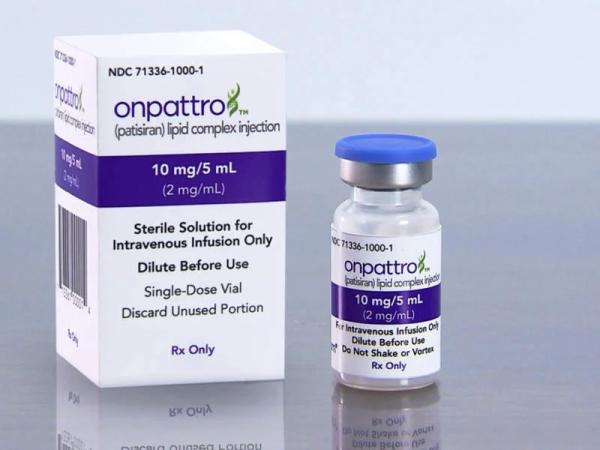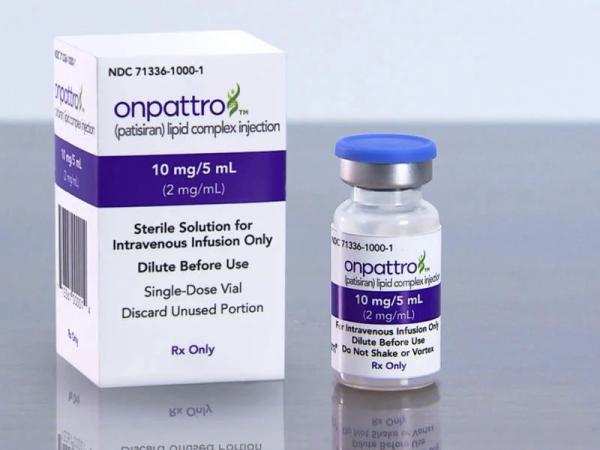
What is Patisiran?
Patisiran is used for the treatment of adults with polyneuropathy of hereditary transthyretin-mediated amyloidosis (damage of multiple nerves throughout the body).
Patisiran could also be used to treat conditions that aren't listed in this guide.
Side effects of Patisiran
See a doctor immediately. If you are experiencing warning signs of an allergic response, such as symptoms of hives, difficulty breathing, and swelling of your lips, face, or tongue,
Certain side effects can occur during the course of an injection. Contact your doctor if you are feeling dizzy, nauseated, lightheaded, or sweaty. or experience headaches, chest tightness, back discomfort, breathing difficulties, or swelling of your face.
Common adverse effects of patisiran could include:
- Symptoms of a cold, like congestion, sneezing, and a sore throat.
This isn't an exhaustive listing of all possible adverse consequences; other effects might occur. Talk to your doctor for medical advice about the consequences. It is possible to report any symptom to the FDA by dialing 1-800-FDA-1088.
Warnings
Follow the instructions on your prescription label. Also, go through all medication guides or instruction sheets. Inform your doctor if you take other medications or suffer from any other medical condition or allergies.
Before you take this drug,
Before taking patisiran, inform your doctor about any medical issues or allergies.
Patisiran may harm an unborn baby. Tell your doctor if you are pregnant. If you're expecting and you are a registered mother, your name could be included on an ob-gyn registry to track how patisiran affects you and the child.
It is not recommended to breastfeed while taking patisiran. Discuss with your doctor any potential risks.
How do I take Patisiran?
Patisiran is administered as an infusion into the vein. Your healthcare provider will administer the injection every three weeks. The medication must be administered slowly, and infusions can be up to 80 minutes long before they are finished.
Contact your physician if you are experiencing any burning, pain, or discomfort around your IV catheter after the patisiran injection is made. You could be prescribed additional medications to help you avoid dangerous side effects and an infusion reaction.
The doctor may recommend that you consume vitamin A when you're taking patisiran. You should only take your vitamin A dosage as your physician has recommended, particularly when you are pregnant. A vitamin A overdose could cause problems with vision and other serious side effects. Consult your physician immediately. If you are experiencing vision issues (especially at night) when you take patisiran, The doses of Patisiran depend on weight. Your dose needs may change if you gain or lose weight.
There is a chance that you will need frequent medical tests. Even if there are no symptoms, tests may aid your doctor in determining the effectiveness of this medicine. You might also require regular eye examinations.
Details on dosage
Usual Adult Dose for Amyloidogenic Transthyretin Amyloidosis:
The recommended dose is based on your actual body weight.
If you weigh less than 100kg, take 0.3 mg/kg intravenously once every 3 weeks.
Weight of 100 kg or more: 30 mg intravenously every 3 weeks
Infuse with a starting rate of around 1 mL/min for the initial 15 minutes. Then, increase to around 3 mL/min for the duration of 80 minutes.
PREMEDICATION: Take it at least one day prior to the infusion and at least 60 minutes prior to the commencement of the infusion.
Oral Acetaminophen 500 mg
Intravenous corticosteroid (e.g., dexamethasone 10 mg or equivalent)
Intravenous H1 blocking agent (e.g., diphenhydramine 50 mg or similar)
intravenous H2 blocker (e.g., ranitidine 50 mg or equivalent)
Comments:
The time of an infusion can be prolonged in the event that the infusion is associated with adverse reactions (IRR).
If intravenous medications are not available or are not accepted, oral equivalents could be prescribed.
If patients tolerate the infusion but are experiencing adverse reactions to the corticosteroid prescription, cut down corticosteroid doses to 2.5 mg increments until the minimum dose of dexamethasone per intravenous injection or something similar.
Some patients might require additional or greater doses of a premedication or a combination to lower the chance of IRRs.
Use: For the treatment of adults with polyneuropathy of hereditary transthyretin-mediated amyloidosis.
What happens if I miss a dose?
Consult your physician for the proper treatment. If you do not make an appointment to receive an injection of patisiran,
What happens if I overdose?
Since patisiran is administered by a health specialist in a medical setting, it is highly unlikely for an overdose to occur.
What should be avoided?
Follow your doctor's advice regarding any restrictions on your food, drink, or activity.
Interaction with other drugs
Other medications may interact with patisiran, such as prescription and over-the-counter medicines, vitamins, and herbal products. Discuss with your doctor your current medications and any medications you begin or stop taking.




